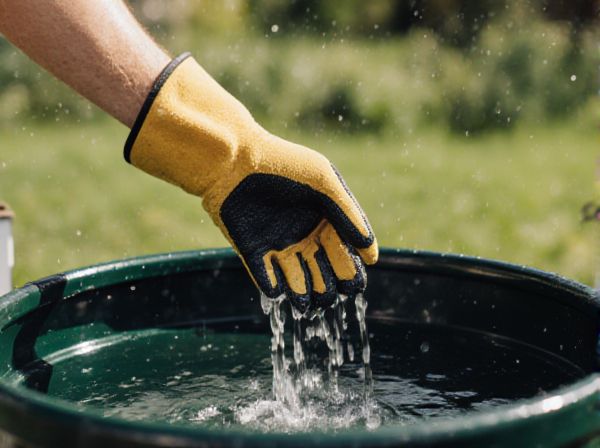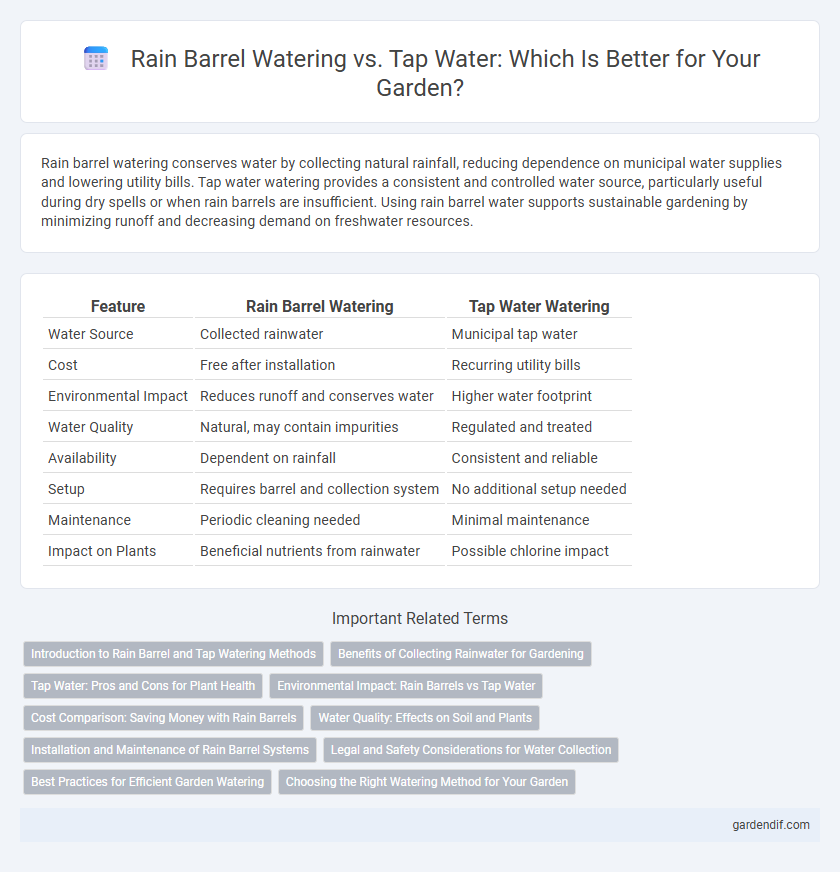
Rain barrel watering vs tap water watering Illustration
Rain barrel watering conserves water by collecting natural rainfall, reducing dependence on municipal water supplies and lowering utility bills. Tap water watering provides a consistent and controlled water source, particularly useful during dry spells or when rain barrels are insufficient. Using rain barrel water supports sustainable gardening by minimizing runoff and decreasing demand on freshwater resources.
Table of Comparison
| Feature | Rain Barrel Watering | Tap Water Watering |
|---|---|---|
| Water Source | Collected rainwater | Municipal tap water |
| Cost | Free after installation | Recurring utility bills |
| Environmental Impact | Reduces runoff and conserves water | Higher water footprint |
| Water Quality | Natural, may contain impurities | Regulated and treated |
| Availability | Dependent on rainfall | Consistent and reliable |
| Setup | Requires barrel and collection system | No additional setup needed |
| Maintenance | Periodic cleaning needed | Minimal maintenance |
| Impact on Plants | Beneficial nutrients from rainwater | Possible chlorine impact |
Introduction to Rain Barrel and Tap Watering Methods
Rain barrel watering collects and stores rainwater from rooftops, offering a sustainable, cost-effective alternative to tap water by reducing dependence on municipal supplies. Tap water watering relies on treated, chlorinated water sourced from public utilities, ensuring consistent quality and availability for irrigation purposes. Utilizing rain barrels can promote environmental conservation by minimizing runoff and reducing water bills while tap water provides convenience and reliability during dry periods.
Benefits of Collecting Rainwater for Gardening
Collecting rainwater for gardening conserves tap water, reducing utility bills and environmental impact by lowering demand on municipal water supplies. Rainwater is naturally soft and free of chlorine and other chemicals, promoting healthier soil and plant growth compared to treated tap water. Utilizing rain barrels also helps manage stormwater runoff, decreasing erosion and preventing pollutants from entering waterways.
Tap Water: Pros and Cons for Plant Health
Tap water provides a consistent and readily available source of hydration for plants, often containing essential minerals like calcium and magnesium that support healthy growth. However, its chlorine or fluoride content can sometimes harm sensitive plant species or soil microbiomes, potentially stunting development over time. Regularly testing and, if necessary, treating tap water helps optimize its suitability for maintaining robust plant health.
Environmental Impact: Rain Barrels vs Tap Water
Rain barrel watering significantly reduces reliance on municipal tap water, conserving freshwater resources and decreasing energy consumption associated with water treatment and distribution. Harvested rainwater is free of chemicals like chlorine and fluoride, minimizing chemical runoff and promoting healthier plant growth. Using rain barrels lowers carbon emissions and helps manage stormwater runoff, reducing erosion and water pollution compared to conventional tap water irrigation.
Cost Comparison: Saving Money with Rain Barrels
Rain barrel watering significantly reduces water bills by collecting free rainwater, lowering reliance on costly tap water for garden irrigation. Using rain barrels can save homeowners up to 50% on outdoor water expenses annually, especially in regions with moderate rainfall. This eco-friendly method not only cuts costs but also conserves municipal water resources, making it a financially and environmentally smart choice.
Water Quality: Effects on Soil and Plants
Rain barrel watering provides natural, chemical-free water that enhances soil health by maintaining beneficial microbial activity and reducing chemical buildup compared to tap water. Tap water often contains chlorine, fluoride, and salts that can alter soil pH and potentially harm sensitive plants over time. Using rain barrel water promotes healthier plant growth and better soil structure by preserving essential nutrients and preventing the accumulation of harmful substances.
Installation and Maintenance of Rain Barrel Systems
Installing a rain barrel system involves positioning the barrel beneath a downspout to collect and store rainwater, requiring basic tools to secure overflow valves and mesh screens that prevent debris and insects from entering. Maintenance includes regularly cleaning gutters, inspecting the barrel for cracks or leaks, and sanitizing the interior to prevent algae growth and mosquito breeding. Compared to tap water systems, rain barrel setups significantly reduce water bills and environmental impact but demand seasonal monitoring to ensure optimal water quality and flow.
Legal and Safety Considerations for Water Collection
Rain barrel watering systems are subject to varying legal regulations depending on the region, with some areas requiring permits or prohibiting rainwater collection to protect municipal water rights. Safety considerations include ensuring that collected rainwater is free from contaminants such as bird droppings, chemicals on roofing materials, or standing water that can breed mosquitoes. Tap water watering, regulated by municipal water authorities, guarantees treated and safe water for plants but often carries higher costs and environmental impact compared to rain barrel collection.
Best Practices for Efficient Garden Watering
Rain barrel watering conserves water by collecting and storing natural rainfall, reducing reliance on municipal tap water and lowering utility costs. Tap water often contains chemicals like chlorine and fluoride, which can affect soil health, whereas rainwater is naturally soft and nutrient-rich, promoting healthier plant growth. To optimize garden efficiency, use rain barrels for regular watering and supplement with tap water during dry periods, ensuring drip irrigation or soaker hoses deliver water directly to plant roots.
Choosing the Right Watering Method for Your Garden
Rain barrel watering conserves freshwater by collecting and utilizing natural rainfall, reducing dependence on municipal tap water and lowering water bills. Tap water often contains chemicals like chlorine and fluoride that may affect soil health and plant growth, whereas rain barrel water is typically free from these additives. Selecting rain barrel watering enhances sustainability and supports healthier garden ecosystems compared to traditional tap water watering.
Rain barrel watering vs tap water watering Infographic

 gardendif.com
gardendif.com